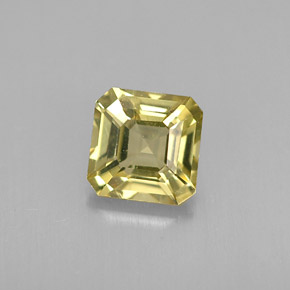The Gemstone Chrysoberyl

Chrysoberyl is a hard, tough, and durable gem. Although lacking the fire of other gemstones, Chrysoberyl in its various forms can be quite valuable. Most Chrysoberyl gems are yellow, though some are brown, green, or orange. Chrysoberyl is best known for its important varieties Alexandrite and Cat's Eye. Alexandrite is a rare and expensive form that exhibits different colors in natural and artificial light. Cat's Eye is Chrysoberyl that is polished into a cabochon and highly chatoyant, displaying a sharp line of light through the center of the stone.
Color
?
Red, Green, Yellow, Orange, Brown, Pink, Gray, Black, Multicolored
Chemical Formula
?
BeAl
2O
4
Mineral Class
?
Chrysoberyl
All About
Chrysoberyl is most often a lightly colored gemstone, though increased color saturation will increase its value. Chrysoberyl gemstones are often free of
flaws, though stones larger than several
carats are uncommon. With a
hardness of 8½, Chrysoberyl is also one of the hardest gemstones.
The
cat's eye effect exhibited on the
Cat's eye variety is caused by is caused by microscopic needle-like
fiber inclusions that cause the light to band together in a thin streak. The term "Cat's eye" when used alone without any gemstone name prefix will always refers to Chrysoberyl Cat's eye, which is the most famous and valuable of the cat's eye gemstones. All cat's eye gemstones other than Chrysoberyl must be designated by their gemstone name, such as "Tourmaline Cat's eye", or Cat's Eye Tourmaline.
Uses
?
All colors of transparent Chrysoberyl can be faceted into gemstones. Despite its appealing and valuable nature, Chrysoberyl is not extensively used in jewelry. The most common colors for Chrysoberyl jewelry are yellow, greenish-yellow, and brownish-yellow.
Cat's Eye is
polished into
cabochons, and usually has a yellow-brown, greenish-brown, greenish-gray, or gray color.
Alexandrite is used as rare and exquisite jewelry piece, and most often faceted into round and cushion cuts that are used in rings and pendants.
Treatments & Enhancements
?
Chrysoberyl gemstones are not treated or enhanced.
Chrysoberyl Sources
?
The most significant Chrysoberyl deposits are in Brazil, but other important deposits are in Australia,
Madagascar, Zimbabwe, Myanmar (Burma), and Russia.
Cat's eye is found in Brazil, India, China, Sri Lanka, and Zimbabwe, and
Alexandrite comes from Brazil, Russia, Madagascar, Sri Lanka and Tanzania.
Similar Gemstones
?
Topaz, Heliodor, Peridot, Yellow Sapphire, Citrine, and
Zircon may resemble Chrysoberyl. Chrysoberyl
Cat's eye can be distinguished from other cat's eye gemstone by its greater hardness.
Chrysoberyl Photos
?
Please see the dedicated pages on the varieties
Alexandrite and
Cat's Eye for additional images.
Chrysoberyl in the Rough Photos
?
Please see the dedicated pages on the varieties
Alexandrite for additional images.